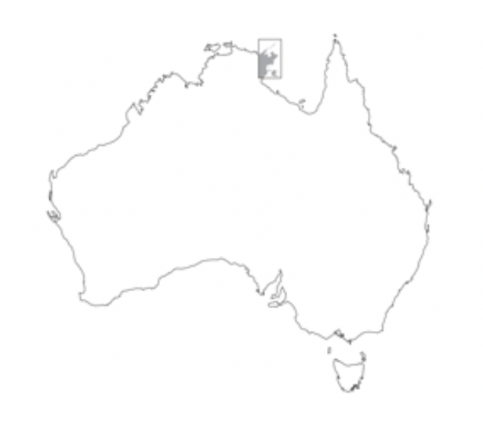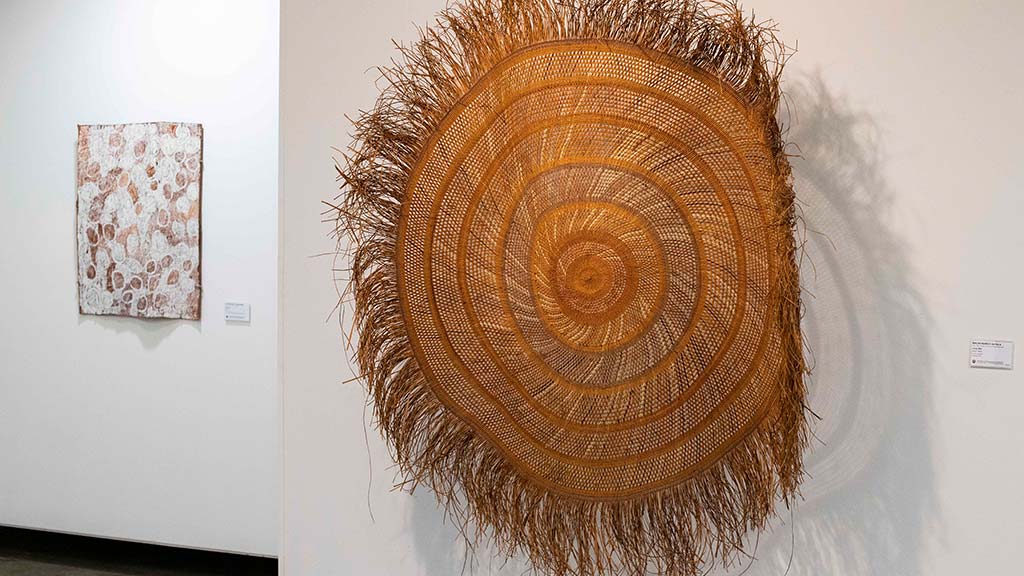April 15, 2019
Exhibition – Ganma: Both Ways
Held in the Long Gallery & TAEM Gallery, curated by Diana Wood Conroy, Catriona Stanton & UOWAC
Yirrkala in 1994-1996 was a small settlement in North-east Arnhem land in the Northern Territory of Australia, with a population of about 2000 people, of whom 400 made bark-paintings, sculptures and weavings. The Yolngu people have 16 clan languages as well as being fluent in English. The first missionaries came to Yirrkala in 1934, and the Nhulunbuy Bauxite Mine close to Yirrkala was established in the 1960s, closing in 2014.
The University of Wollongong -Yirrkala Exchange began with a friendship. Diana Wood Conroy first knew Banduk Marika in1986 when they were both working in North Sydney on a book with Jennifer Isaacs called Bush Food: Aboriginal Food and Medicine (Lansdowne, Sydney, 1987).
In 1991 Diana became a lecturer in Visual Arts at the then School of Creative Arts and invited Banduk Marika to be artist-in-residence. In 1994 Banduk rang her to suggest setting up an exchange between artists and students in both Yirrkala and Wollongong. The National Priority Development Fund provided a substantial grant over three years, with the Dean of Creative Arts, Professor Sharon Bell guiding the project.
The aims were first, to provide arts training and skills as directed by the community particularly silk-screening and printmaking on textiles and on paper. Secondly, to have artist-in-residency exchanges with artists flowing between both centres. Four workshops in printmaking on paper and textiles were held in Yirrkala by artists from Wollongong, and artists from Yirrkala visited and exhibited in Project Space Wollongong in January and in the Long Gallery in August 1995. Both exhibitions were called Freshwater Saltwater.
Banduk Marika and Gaymala Yunupingu organised field trips along the beach and into the bush near Yirrkala in their capacity as Yolngu artists guiding the tutors and students from the then Faculty of Creative Arts at the University of Wollongong. T
The southern artists – among them Kathy Orton, Rachel Burns, Sue Blanchfield, Jonathan Greenwell and Diana Wood Conroy – had been invited to give workshops in printmaking and textiles at the Yirrkala Community School during 1995. Sue Blanchfield made an exceptional contribution through her work with Yolngu artists in silkscreen, batik and linocuts on textiles. Later, sculptor Ian Gentle, printmaker Linda Dodds and musicians Houston Dunleavy and Andrew Schultz also exchanged ideas with people in Yirrkala.
The contributions of UOW Yirrkala artists-in-residence Banduk Marika, Gaymala Yunupingu, Dopiya Gurruwiwi, Dhangal and Djalu Gurruwiwi, Milminyina Dhamarranji, and Witiyana Marika were memorable. Gaymala liked to work on a blanket under a gum tree in the courtyard, talking to students but never stopping her cutting. Local Indigenous artists and students from TAFE visited. Every Yolngu artist worked from 9am to 5 pm cutting linos slowly and carefully and then printing them in the studios, showing a seriousness and commitment that was a great role model for students. Trips were made to the ancient Wodi Wodi and Dharawal sites at Bass Point and East Corrimal and a yidaki (didgeridoo) workshop was held with Djalu, (a renowned expert in Yolngu music as well as a superb artist) for the men of the Faculty.
A distinctive aspect of the UOW Collection is the work by children, here represented by Gayili, Gwalilnga, Benki and Rrawun Maymuru. When the children first started cutting linocuts in the Yirrkala School Workshops they thought about a clan pattern, and the results were compelling.
To comprehend Yolngu art, field trips along the coast and hinterland around Yirrkala with Banduk and Gaymala helped the UOW artists to understand the interconnection of all aspects of Yolngu life - the land as sustenance, its origin in the creation ancestors and the role of artists as custodians of certain areas of land inherited through the structures of kinship and language. All Banduk’s paintings and prints show aspects of the sacred sites of the ancestors.
Banduk Marika’s father, Mawalan Marika, and brother Wandjuk Marika, were ceremonial leaders who also reached out to the wider Australian community, believing that if the ‘balanda’ (white) leaders could acknowledge the powerful intricacy and dignity of Yolngu law, the relationship between the two cultures could be based on mutual respect, rather than domination. Her daughter Ruby Marika continues working between balanda (white) and Yolngu ways.
Nalwarri Ngurrawuthun, the Principal of the Yirrkala School underlined the necessity of ‘both ways’ when opening an exhibition of Yirrkala artwork Freshwater Saltwater at the University of Wollongong in July 1995. She emphasised that both cultures need to interact closely, while respecting intrinsic difference, as expressed in the idea of ganma, the Yolngu system of knowledge which Mandawuy Yunupingu described in the ABC Boyer Lectures for 1994 as like a pool of brackish water:
“In each of the sources of flowing water there is ebb and flow. The deep pool of brackish water is a complex dynamic balance. In the same ways, balance of Yolngu life is achieved through the ebb and flow of competing interests, through our elaborate kinship system. And I feel that in the same ways balance between black and white in Australia can be achieved.”
“What is art in Yolngu culture?” asked Bert Flugelman, lecturer in sculpture in a seminar with Banduk Marika in 1991. She responded “Art is our roots, but we don't call it 'art'. Art is our land.”. On Australia Day 2019 Banduk Marika was appointed an Officer of the Order of Australia (AO) for distinguished service to the visual arts, particularly to Indigenous printmaking and bark painting, and through cultural advisory roles.
Raymattja Marika-Mununggiritj from Yirrkala expressed the complexity of art-making: “If we as Yolngu, dig and explore into one thing, there are other areas to be understood and to be learnt about, which have the same sort of balance and meaning to them. On one side, for example, there is the ‘dhulang’ (sacred art) and on the other side there is the ‘manukay’ (clan songs), solidly linked to each other. We all have to learn and understand it together to have it all integrated.”[1]
Art in all mediums cannot be understood without relating to a whole body of knowledge in history, mythology and ancestors.
Emeritus Professor Diana Wood Conroy
Faculty of Law Humanities and Arts
University of Wollongong
NSW Australia
March 15, 2019

Map of Australia showing the location of
north-east Arnhem Land and the Yirrkala region. Image courtesy of Art Gallery NSW
[1]Raymattja Marika-Mununggiritj, How can Balanda (White Australians) learn about the Aboriginal world? Ngoonjook, Batchelor Journal of Aboriginal Education, July 1991, p. 18. Quoted in Diana Wood Conroy “Both ways: Yolngu and Ngarrindjeri weaving in Australian arts practice” in Craft and Contemporary Theory: an anthology of critical writing on the crafts, Sue Rowley (ed), Allen and Unwin, Sydney, 1997.
